Citroen C4 RHD 2015 2.G Owner's Manual
Manufacturer: CITROEN, Model Year: 2015, Model line: C4 RHD, Model: Citroen C4 RHD 2015 2.GPages: 328, PDF Size: 12.72 MB
Page 161 of 328
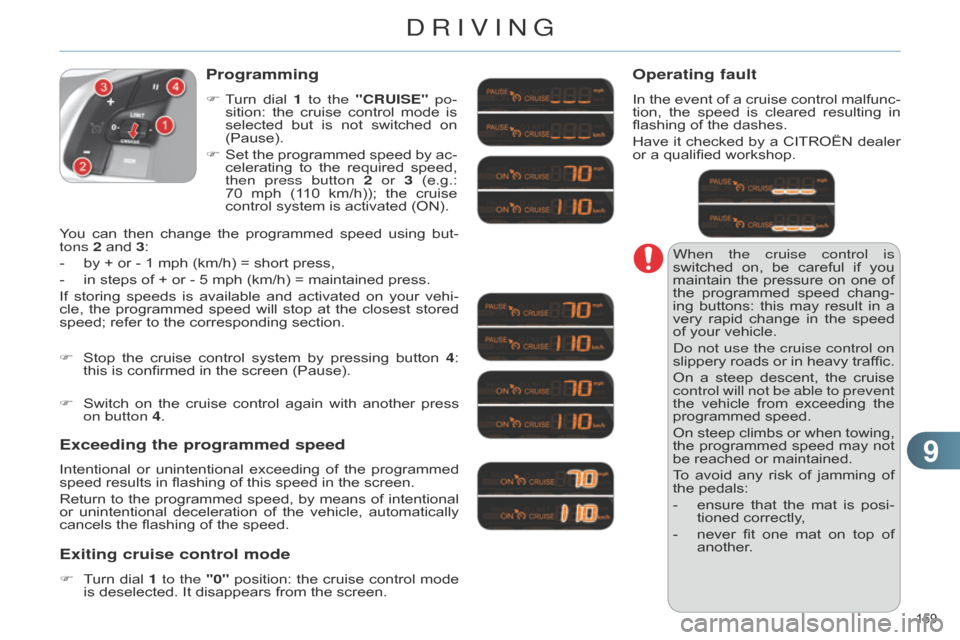
99
159
When the cruise control is
switched on, be careful if you
maintain
the
pressure
on
one
of
the
programmed
speed
chang
-
ing
buttons:
this
may
result
in
a
very
rapid
change
in
the
speed
of
your vehicle.
d
o not use the cruise control on
slippery
roads
or
in
heavy
traffic.
On
a
steep
descent,
the
cruise
control will not be able to prevent
the
vehicle
from
exceeding
the
programmed
speed.
On
steep
climbs
or
when
towing,
the
programmed
speed
may
not
be
reached or maintained.
To
avoid
any
risk
of
jamming
of
the
pedals:
-
ensure
that
the
mat
is
posi
-
tioned
correctly,
-
never
fit
one
mat
on
top
of
another
.
Programming
F Turn dial 1 to the "CRUISE" po-
sition: the cruise control mode is
selected
but
is
not
switched
on
(Pause).
F
Set
the
programmed
speed
by
ac
-
celerating
to
the
required
speed,
then press button
2 or 3
(e.g.:
70
mph
(1
10
km/h));
the
cruise
control
system is activated (ON).
Exceeding the programmed speed
Intentional or unintentional exceeding of the programmed speed
results in flashing of this speed in the screen.
Return
to
the
programmed
speed,
by
means
of
intentional
or
unintentional
deceleration
of
the
vehicle,
automatically
cancels
the flashing of the speed.
Exiting cruise control mode
F Turn dial 1 to the "0" position: the cruise control mode is
deselected. It disappears from the screen.
F
Stop
the
cruise
control
system
by
pressing
button
4
:
this
is confirmed in the screen (Pause).
Operating fault
In the
event of a cruise control malfunc -
tion, the speed is cleared resulting in
flashing
of the dashes.
Have
it
checked
by
a
CITROËN
dealer
or
a qualified workshop.
You
can
then
change
the
programmed
speed
using
but
-
tons
2
and
3:
-
by
+
or
-
1
mph
(km/h)
=
short
press,
-
in
steps
of
+
or
-
5
mph
(km/h)
=
maintained
press.
If
storing
speeds
is
available
and
activated
on
your
vehi
-
cle,
the
programmed
speed
will
stop
at
the
closest
stored
speed;
refer
to
the
corresponding
section.
F
Switch
on
the
cruise
control
again
with
another
press
on button
4.
DRIVING
Page 162 of 328

99
160
PARKING SPACE SENSORS
System which measures the parking space
available between two vehicles
or
obstacles.
It
measures
the
size
of
the
space
and gives you information on:
-
the
possibility
of
fitting
into
a
free space,
depending
on
the
dimensions of
your
vehicle
and
the
distances needed
for manoeuvring,
-
the
level
of
difficulty
of
the
manoeuvre to
be performed.
The
system
does
not
measure
spaces
which
are
clearly
much
smaller
or
larg
-
er
than the size of the vehicle.Displays in the instrument panel
- on fixed: the function is selected by a press on control
A.
-
off:
the function is not selected,
The
parking
space
sensor
function
warning
lamp
can
have
two different states:
Operation
You have identified a parking space:
F
Press button
A
to select the function.
F
Operate
the
direction
indicator
on
the
side
where
the
space
is
to
be
measured;
a
message
is
displayed
to
confirm
that
measurement
is
in
progress.
F
During
measurement,
go
forward
the
length
of
the
space,
at
a
speed
less
than
12
mph
(approx.
20
km/h),
to
prepare for your manoeuvre.
F
Once
the
measurement
has
been
completed,
the
system
informs
you
of
the
level
of
difficulty
of
the
ma
-
noeuvre
by
a
message
in
the
multi
-
function
screen
accompanied
by
an
audible
signal.
DRIVING
Page 163 of 328

99
161
The function displays the following types of
message:
Parking possible
Parking difficult
Parking not advised The
function deselects itself automati -
cally:
-
when
you engage reverse gear,
-
when
you switch off the ignition,
-
if
measuring is not requested,
-
within
five
minutes
of
selection
of
the function,
-
if
the
vehicle
speed
exceeds
the
threshold of 45 mph (approx. 70 km/h) for one minute.
If
the
lateral
distance
between
your
ve
-
hicle
and
the
parking
space
is
too
large,
the
system
may
not
be
able
to
measure
the
space.
If there is a fault, have the sys-
tem
checked
by
a
CITROËN
dealer
or a qualified workshop.
The
system
remains
available
after
each
measurement
and
can
therefore
measure
several spaces in succession.
In poor or wintry weather, ensure that
the
sensors
are
free
of
dirt,
ice
or
snow
.
The
parking
space
sensor
system
de
-
activates
the
front
parking
sensors
when
measuring forwards.
DRIVING
Page 164 of 328

99
162
PARKING SENSORS
This system indicates the proximity of
an obstacle (person, vehicle, tree,
gate, etc.)
which
comes
within
the
field of
detection
of
sensors
located
in
the bumper
.
Certain
types
of
obstacle
(stake,
road
-
works
cone,
etc.)
detected
initially
will
no
longer
be
detected
at
the
end
of
the
manoeuvre
due
to
the
presence
of
blind
spots.
This function cannot, in any cir
-
cumstances,
take
the
place
of
the
vigilance of the driver.The
system
is
switched
on
by
engaging
reverse
gear
.
This
is
accompanied
by
an
audible signal.
The
system
is
switched
of
f
when
you
come
out of reverse gear.
Rear parking sensors
Audible assistance
The
proximity
information
is
given
by
an
intermittent
audible
signal,
the
frequen
-
cy of which increases as the vehicle ap-
proaches
the obstacle.
The
sound
emitted
by
the
speaker
(right
or
left)
indicates
the
side
on
which
the
obstacle
is located.
When
the
distance
between
the
vehicle
and
the
obstacle
becomes
less
than
approximately
thirty
centimetres,
the
audible
signal becomes continuous.Visual assistance
This
supplements
the
audible
signal
by
displaying
bars
in
the
multifunction
screen
which
move
progressively
near
-
er
to
the
vehicle.
When
the
obstacle
is
near
,
the
"Danger"
symbol
is
displayed
in
the screen.
DRIVING
Page 165 of 328

99
163
In addition to the rear parking sensors, the
front parking sensors are triggered when
an
obstacle
is
detected
in
front and
the
speed
of
the
vehicle
is
still
below 6
mph (10 km/h).
The
front parking sensors are interrupted
if
the
vehicle
stops
for
more
than
three seconds
in
forward
gear
,
if
no
further
ob
-
stacles
are
detected
or
when
the
speed of
the vehicle exceeds 6 mph (10 km/h).
Front parking sensorsDeactivation/Activation of the front
and rear parking sensors
The
function
is
deactivated
by
pressing
this
button.
The
indicator
lamp
in
the
button
comes on.
Pressing
this
button
again
reactivates
the
function.
The
indicator
lamp
in
the
button
goes off.Operating fault
The function will be deactivated automatically
if a trailer is being
towed
or
a
bicycle
carrier
is
fit
-
ted
(vehicle
fitted
with
a
towbar
or
bicycle
carrier
recommended
by
CITROËN). In
bad
weather
or
in
winter
,
en
-
sure that the sensors are not
covered
with
mud,
ice
or
snow
.
When
reverse
gear
is
engaged,
an
audible
signal
(long
beep)
in
-
dicates
that
the
sensors
may
be
dirty
.
Certain
sound
sources
(motor
-
cycle,
lorry
,
pneumatic
drill,
etc.)
may
trigger
the
audible
signals
of
the parking sensor system.
In
the
event
of
a
malfunction
of
the
system,
when
reverse
gear
is
engaged
this
warn
-
ing
lamp
is
displayed
in
the
instrument
panel
and/or
a
message
appears
in
the
screen,
accompanied
by
an
audible
signal
(short beep).
Contact
a
CITROËN
dealer
or
a
quali
-
fied workshop.
The
sound
emitted
by
the
speaker
(front
or
rear)
indicates
whether
the
obstacle
is
in
front
or
behind.
DRIVING
Page 166 of 328
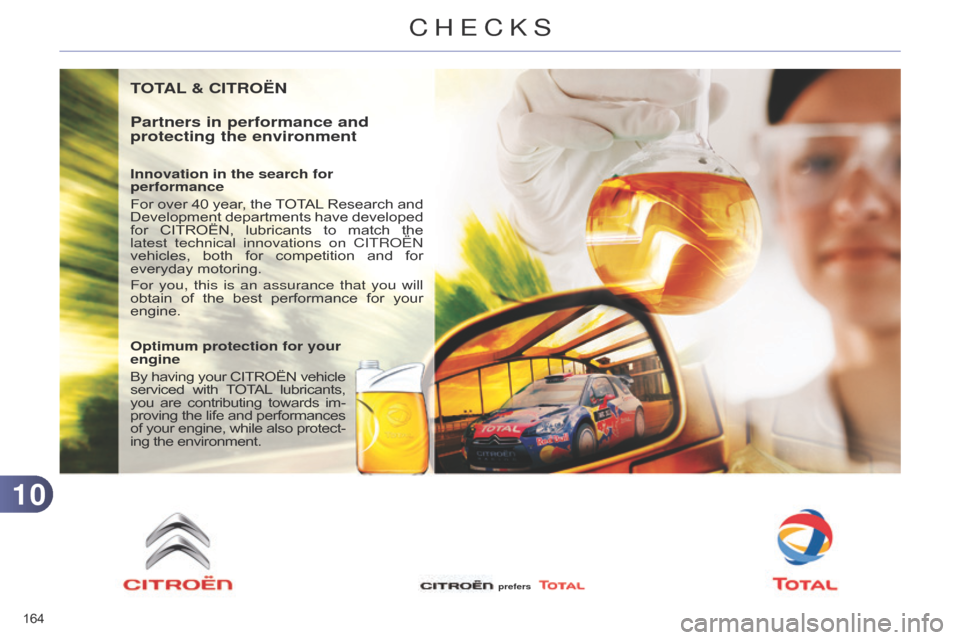
1010
164
TOTAL & CITROËN
Partners in performance and
protecting the environment
Innovation in the search for
performance
For
over
40
year
,
the
T
OTAL
Research
and
Development
departments
have
developed
for
CITROËN,
lubricants
to
match
the
latest technical innovations on CITR
o Ë n
vehicles,
both
for
competition
and
for
everyday
motoring.
For you, this is an assurance that you will
obtain
of
the
best
performance
for
your
engine.
Optimum protection for your
engine
By
having
your
CITROËN
vehicle serviced
with
T
OTAL
lubricants, you
are
contributing
towards
im
-
proving
the
life
and
performances of
your
engine,
while
also
protect
-
ing
the environment.
prefers
CHECKS
Page 167 of 328
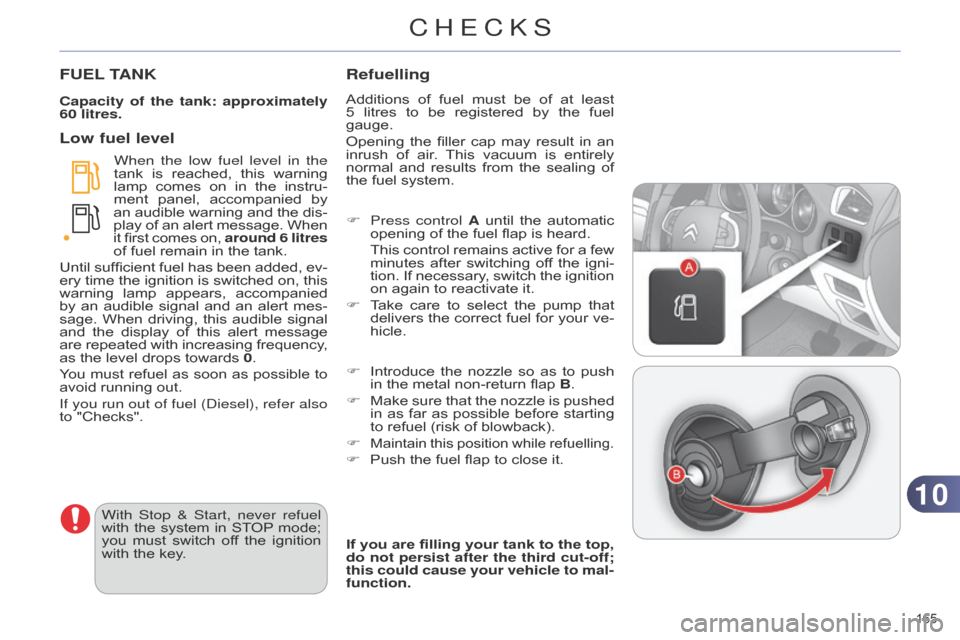
1010
165
FUEL TANK
Capacity of the tank: approximately
60 litres.
When the low fuel level in the
tank
is
reached,
this
warning
lamp
comes
on
in
the
instru
-
ment
panel,
accompanied
by
an
audible
warning
and
the
dis
-
play
of
an
alert
message.
When
it
first
comes
on,
around
6 litres
of
fuel remain in the tank.
Until
sufficient
fuel
has
been
added,
ev
-
ery
time
the
ignition
is
switched
on,
this
warning
lamp
appears,
accompanied
by
an
audible
signal
and
an
alert
mes
-
sage.
When
driving,
this
audible
signal
and
the
display
of
this
alert
message
are
repeated
with
increasing
frequency
,
as
the level drops towards 0.
You
must
refuel
as
soon
as
possible
to
avoid
running out.
If you run out of fuel (
d iesel), refer also
to
"Checks".
Low fuel level Refuelling
Additions of
fuel must be of at least
5 litres to be registered by the fuel
gauge.
Opening
the
filler
cap
may
result
in
an
inrush
of
air
.
This
vacuum
is
entirely
normal
and
results
from
the
sealing
of
the
fuel system.
F
Press control
A
until
the
automatic
opening
of the fuel flap is heard.
This
control
remains
active
for
a
few
minutes
after
switching
of
f
the
igni
-
tion.
If
necessary
,
switch
the
ignition
on
again to reactivate it.
F
T
ake
care
to
select
the
pump
that
delivers
the
correct
fuel
for
your
ve
-
hicle.
If you are filling your tank to the top,
do not persist after the third cut-off;
this could cause your vehicle to mal-
function.
With Stop & Start, never refuel
with
the
system
in
ST
OP
mode;
you
must
switch
of
f
the
ignition
with
the
key. F
Introduce
the
nozzle
so
as
to
push
in
the metal non-return flap B.
F
Make
sure
that
the
nozzle
is
pushed
in
as
far
as
possible
before
starting
to
refuel (risk of blowback).
F
Maintain this position while refuelling.
F Push the fuel flap to close it.
CHECKS
Page 168 of 328
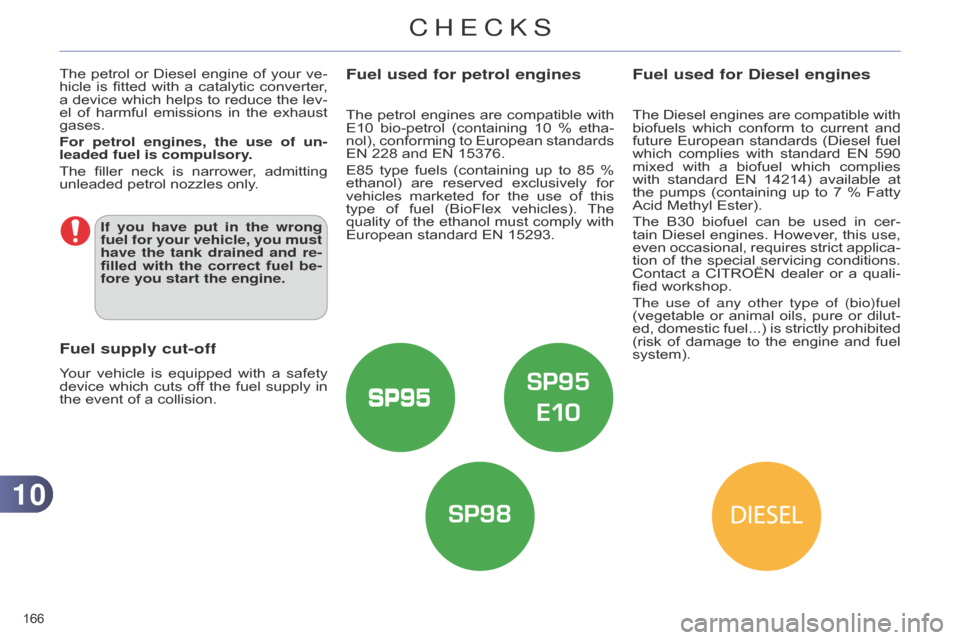
1010
166
Fuel used for petrol engines
The petrol engines are compatible with E10
bio-petrol (containing 10 % etha -
nol),
conforming
to
European
standards
EN
228 and EN 15376.
E85
type
fuels
(containing
up
to
85
%
ethanol)
are
reserved
exclusively
for
vehicles
marketed
for
the
use
of
this
type
of
fuel
(BioFlex
vehicles).
The
quality
of
the
ethanol
must
comply
with
European
standard EN 15293.
Fuel used for Diesel engines
The Diesel engines are compatible with biofuels
which conform to current and
future
European
standards
(Diesel
fuel
which
complies
with
standard
EN
590
mixed
with
a
biofuel
which
complies
with
standard
EN
14214)
available
at
the
pumps
(containing
up
to
7
%
Fatty
Acid
Methyl Ester).
The
B30
biofuel
can
be
used
in
cer
-
tain
Diesel
engines.
However
,
this
use,
even
occasional,
requires
strict
applica
-
tion
of
the
special
servicing
conditions.
Contact
a
CITROËN
dealer
or
a
quali
-
fied
workshop.
The use of any other type of (bio)fuel
(vegetable
or
animal
oils,
pure
or
dilu
t-
ed,
domestic
fuel...)
is
strictly
prohibited
(risk
of
damage
to
the
engine
and
fuel
system).
The
petrol
or
Diesel
engine
of
your
ve
-
hicle
is
fitted
with
a
catalytic
converter
,
a
device
which
helps
to
reduce
the
lev
-
el
of
harmful
emissions
in
the
exhaust
gases.
For petrol engines, the use of un
-
leaded fuel is compulsory.
The
filler
neck
is
narrower
,
admitting
unleaded
petrol
nozzles
only.
Fuel supply cut-off
Your vehicle is equipped with a safety device
which cuts of f the fuel supply in
the
event of a collision.
If you have put in the wrong
fuel for your vehicle, you must
have the tank drained and re-
filled with the correct fuel be-
fore you start the engine.
CHECKS
Page 169 of 328
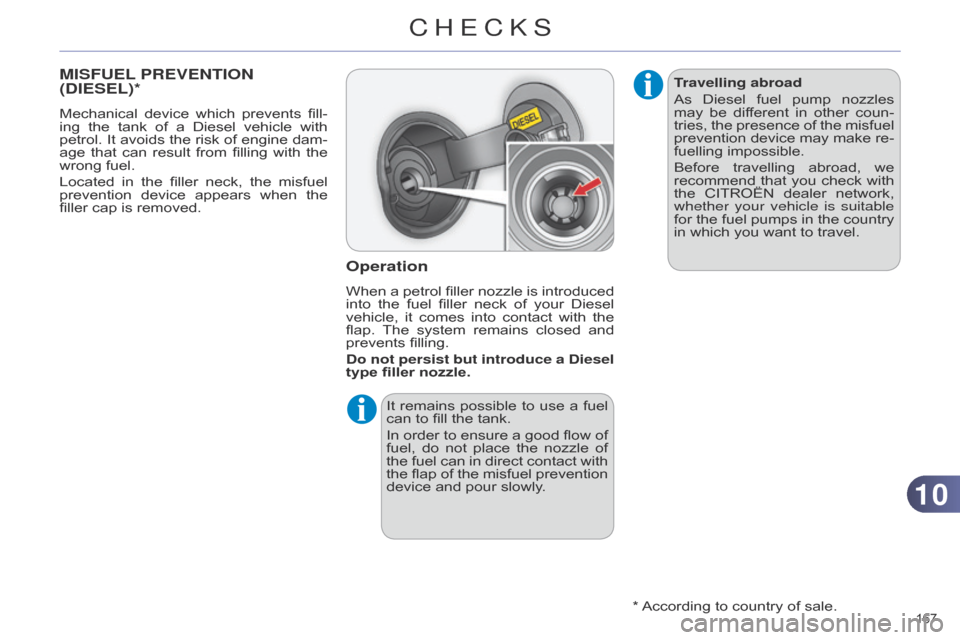
1010
167
MISFUEL PREVENTION
(D IESEL )*
Mechanical device which prevents fill -
ing the tank of a Diesel vehicle with
petrol.
It
avoids
the
risk
of
engine
dam
-
age
that
can
result
from
fillin
g
with
the
wrong
fuel.
Located
in
the
filler
neck,
the
misfuel
prevention
device
appears
when
the
filler
cap is removed.
Operation
When a petrol filler nozzle is introduced into
the fuel filler neck of your Diesel
vehicle,
it
comes
into
contact
with
the
flap.
The
system
remains
closed
and
prevents
filling.
Do not persist but introduce a Diesel
type filler nozzle.
It
remains
possible
to
use
a
fuel
can
to fill the tank.
In
order
to
ensure
a
good
flow
of
fuel,
do
not
place
the
nozzle
of
the
fuel
can
in
direct
contact
with
the
flap
of
the
misfuel
prevention
device
and pour slowly.*
According
to country of sale.
Travelling abroad
As
Diesel
fuel
pump
nozzles
may
be
dif
ferent
in
other
coun
-
tries,
the
presence
of
the
misfuel
prevention
device
may
make
re
-
fuelling impossible.
Before
travelling
abroad,
we
recommend
that
you
check
with
the
CITROËN
dealer
network,
whether your vehicle is suitable
for
the
fuel
pumps
in
the
country
in
which you want to travel.
CHECKS
Page 170 of 328
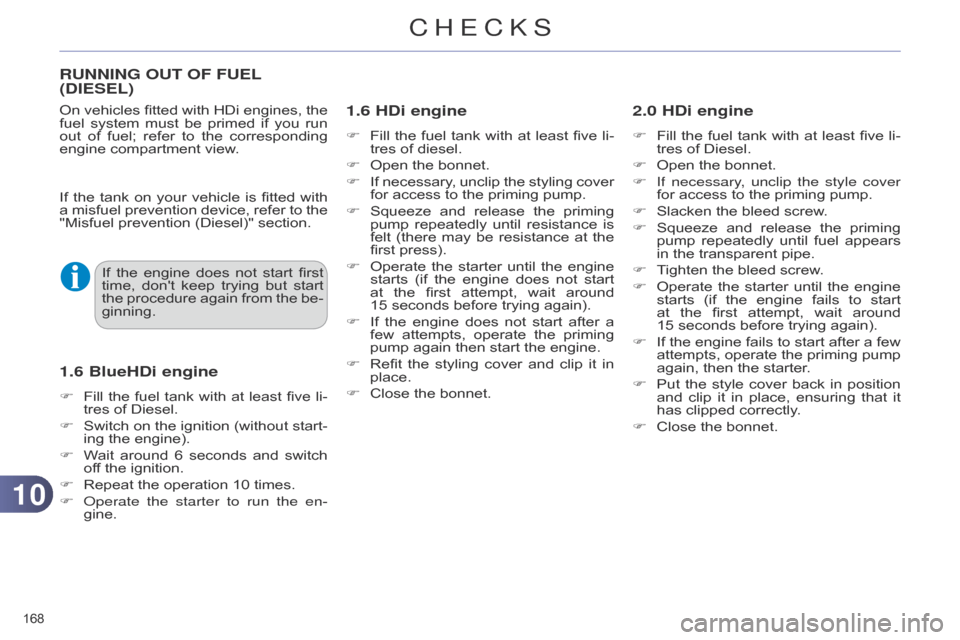
1010
168
RUNNING OUT OF FUEL
(D IESEL )
1.6 HDi engine
F Fill the fuel tank with at least five li -
tres of diesel.
F
Open
the bonnet.
F
If
necessary
,
unclip
the
styling
cover
for
access to the priming pump.
F
Squeeze
and
release
the
priming
pump
repeatedly
until
resistance
is
felt
(there
may
be
resistance
at
the
first
press).
F
Operate
the
starter
until
the
engine
starts
(if
the
engine
does
not
start
at
the
first
attempt,
wait
around
15 seconds
before trying again).
F
If
the
engine
does
not
start
after
a
few
attempts,
operate
the
priming
pump
again then start the engine.
F
Refit
the
styling
cover
and
clip
it
in
place.
F
Close
the bonnet.
2.0 HDi engine
F Fill the fuel tank with at least five li -
tres of Diesel.
F
Open
the bonnet.
F
If necessary
, unclip the style cover
for
access to the priming pump.
F
Slacken
the bleed screw.
F
Squeeze
and
release
the
priming
pump
repeatedly
until
fuel
appears
in
the transparent pipe.
F
T
ighten the bleed screw.
F
Operate
the
starter
until
the
engine
starts
(if
the
engine
fails
to
start
at
the
first
attempt,
wait
around
15 seconds
before trying again).
F
If
the
engine
fails
to
start
after
a
few
attempts,
operate
the
priming
pump
again,
then the starter.
F
Put
the
style
cover
back
in
position
and
clip
it
in
place,
ensuring
that
it
has
clipped correctly.
F
Close
the bonnet.
If
the
engine
does
not
start
first
time,
don't
keep
trying
but
start
the
procedure
again
from
the
be
-
ginning.
On
vehicles
fitted
with
HDi
engines,
the
fuel
system
must
be
primed
if
you
run
out
of
fuel;
refer
to
the
corresponding
engine
compartment
view.
If
the
tank
on
your
vehicle
is
fitted
with
a
misfuel
prevention
device,
refer
to
the
"Misfuel
prevention
(Diesel)"
section.
1.6 BlueHDi engine
F Fill the fuel tank with at least five li -
tres of Diesel.
F
Switch
on
the
ignition
(without
start
-
ing
the engine).
F
W
ait
around
6
seconds
and
switch
of
f the ignition.
F
Repeat
the operation 10 times.
F
o perate the starter to run the en-
gine.
CHECKS